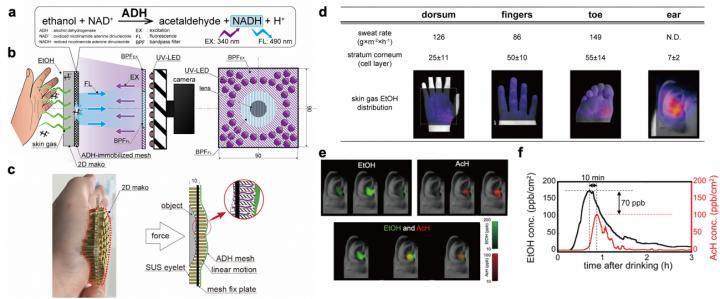
Credit: Department of Biomedical Devices and Instrumentation,TMDU
Researchers from Tokyo Medical and Dental University develop a novel gas imaging system to simultaneously visualize and measure gases that are released through the skin in real-time
Tokyo, Japan – Gases emitted from the human body have been used since ancient Greek times to diagnose the sick; the same principle with a modern, technological makeover could now become a simple tool to identify metabolic disorders, genetic diseases and cancer.
A new method, developed by researchers from Tokyo Medical and Dental University and recently published in the journal ACS Sensors, now makes it possible to image and measure gases, called volatile organic compounds or VOCs, that are released through the skin in real-time.
VOCs that are released through the skin reflect the VOCs present in circulating blood. It is known that certain VOCs, such as ethanol, which is a component of alcoholic beverages, are significantly related to alcohol metabolism. Besides, it has been reported that VOCs would be associated with certain skin diseases, such as psoriasis. Although VOCs can already be commonly analyzed in laboratories using big, expensive machines, convenient, practical devices that provide accurate measurements for routine use in the clinical setting have been lacking. In addition, being able to see how gases are released through the skin over time has remained a challenge.
“We wanted to develop a tool that makes it easy to monitor human health in a non-invasive way,” says the corresponding author of the study Prof. Kohji Mitsubayashi. “Even dating back to ancient Greece, physicians knew that a patient’s breath could offer clues to their ailments. And nowadays, everybody has heard of the breathalyzer. The problem with breath is that it is not suitable for long-term monitoring of VOCs. The skin, on the other hand, offers an easy way for the continuous monitoring of VOCs without putting extra burden on the individual.”
To achieve their goal, the researchers mounted a ring light consisted of an array of UV light-emitting diodes on a camera lens, which together enabled the real-time imaging of VOCs emanated from the skin surface. In a proof-of-principle experiment, the researchers aimed to detect ethanol in a subject who had consumed alcohol. Because the skin surface can be uneven, they used a so-called “2D Mako” to equalize the complex skin surface and to enable the accurate measurement of ethanol over time. To facilitate the detection of ethanol, the researchers drew on the same principle as the human body uses to get rid of ethanol by placing a mesh with an enzyme called alcohol dehydrogenase (ADH) on the subject’s skin via 2D Mako. Once gaseous ethanol hit this mesh, a byproduct of the enzymatic reaction, NADH was generated and emitted fluorescence, which was utilized to gas-imaging.
“We were able to show a dynamic change in the concentration of ethanol over time after alcohol consumption,” says postdoctoral research fellow and lead author of the study Kenta Iitani. “Our results indicate that metabolic monitoring and early disease screening can be achieved by measuring blood VOCs via transcutaneous gas release”.
Being able to reliably measure VOCs could help clinicians to evaluate how alcohol influences the skin and contributes to the development of skin disorders. Adaptation of this gas imaging system to other gases could further enable the study of other diseases by monitoring the release of VOCs.
###
The article, “Transcutaneous Blood VOC Imaging System (Skin-Gas Cam) with Real-Time Bio-Fluorometric Device on Rounded Skin Surface,” was published in ACS Sensors at DOI: 10.1021/acssensors.9b01658
Media Contact
Kohji MITSUBAYASHI
[email protected]
Original Source
http://www.
Related Journal Article
http://dx.




